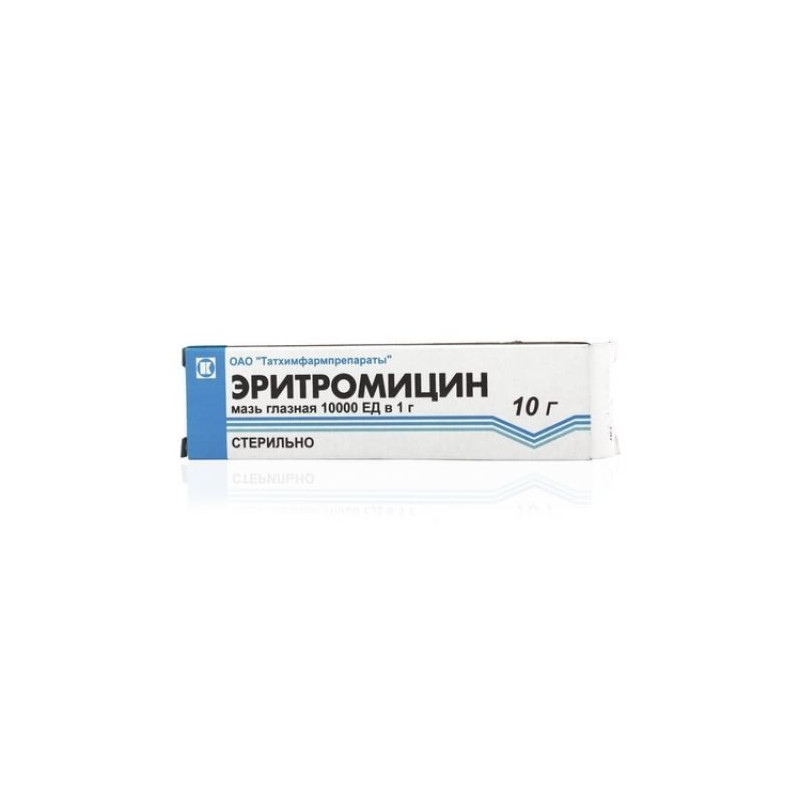



 All payments are encrypted via SSL
All payments are encrypted via SSL
 Full Refund if you haven't received your order
Full Refund if you haven't received your order
10 g
ERYTHROMYCIN is an macrolide antibiotic. It has a bacteriostatic effect. However, in high doses in relation to sensitive microorganisms has a bactericidal effect. Erythromycin reversibly binds to the ribosomes of bacteria, thereby inhibiting protein synthesis. The spectrum of action includes gram-positive (Staphylococcus spp., Producing and not producing penicillinase; lymphocytes; Streptococcus spp., Including S.pneumoniae, Clostridium spp., Bacillus anthracis, Corynebacterium diphtheriae) and some Gram-Negative bacteria; pertussis, Brucella spp., Legionella spp.), Mycoplasma spp., Chlamydia spp., Spirochaetaceae, Rickettsia spp. Gram-negative rods are resistant to erythromycin, incl. Escherichia coli, Pseudomonas aeruginosa, as well as Shigella spp., Salmonella spp.
Eye infections caused by susceptible microorganisms: conjunctivitis (including in newborns), neonatal ophthalmia, bacterial blepharitis, blepharoconjunctivitis, keratitis, meybomit (barley), chlamydia, trachoma.
Hypersensitivity, jaundice (in history), hepatic and / or renal failure, concomitant use of terfenadine or astemizole.
In case of eye diseases - 0.2-0.3 g of ointment is applied for the lower or upper eyelid 3 times a day, for trachoma - 4-5 times a day, the duration of treatment is up to 4 months.
Possible: abnormal liver function, nausea, vomiting, epigastric pain, skin allergic reactions.
Seldom: cholestatic jaundice, anaphylactic shock.
Local reactions: hyperemia, burning, itching, irritation and flaking of the skin; irritation of the mucous membrane of the eye, blurred vision.
Erythromycin is incompatible with Lincomycin, Clindamycin and chloramphenicol due to antagonism of action.
When taken simultaneously with terfenadine or astemizole increases the risk of arrhythmias.
With the simultaneous use of Erythromycin with drugs that block tubular secretion, the half-life of erythromycin is prolonged.
Erythromycin reduces the bactericidal effect of beta-lactam antibiotics (penicillins, cephalosporins, carbapenems).
With simultaneous use of Erythromycin with theophylline increases the concentration of the latter.
With simultaneous use with drugs whose metabolism occurs in the liver (carbamazepine, valproic acid, hexobarbital, phenytoin, alfentanil, disopyramide, lovastatin, bromocriptine), the concentration of these drugs in the plasma may increase, because Erythromycin is an inhibitor of liver microsomal enzymes.
Erythromycin increases cyclosporine nephrotoxicity (especially in patients with concomitant renal failure).
Erythromycin reduces the clearance of triazolam and midazolam, and therefore may enhance the pharmacological effects of these benzodiazepines.
With simultaneous use of Erythromycin with dihydroergotamine or unhydrogenated ergot alkaloids, vasoconstriction with the development of spasms, dysesthesia is noted.
Erythromycin slows down the excretion and enhances the effects of methylprednisolone, felodipine, and coumarin anticoagulants.
With a joint appointment with lovastatin may develop rhabdomyolysis.
Erythromycin increases the bioavailability of Digoxin and reduces the effectiveness of hormonal contraception.
